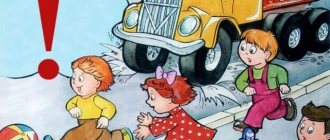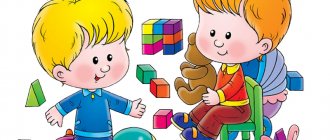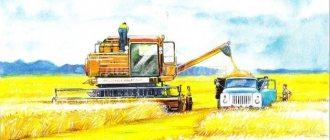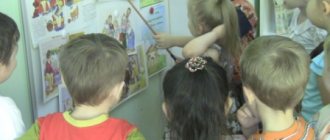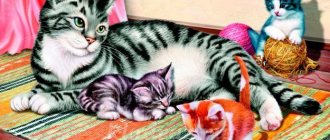Methods of teaching preschoolers storytelling from a picture
Maria Artamonova
Methods of teaching preschoolers storytelling from a picture
Methodological development on the topic : “ Methodology of storytelling based on a picture ”
.
Painting is one of the main attributes of the educational process at the stage of preschool childhood . its positive advantages over other didactic means are disclosed in sufficient detail in teaching aids and textbooks on education (M. M. Konina, E. P. Korotkova, O. I. Radina, E. I. Tikheeva, S. F. Russova, etc. ).
Pictures for working with children are distinguished according to the following criteria: format (demonstration and handouts, themes (natural or objective world, the world of relationships and art, content (artistic, didactic; subject, plot), character (real, symbolic, fantastic, problematic-mysterious, humorous image) and a functional method of application (an attribute for a game, a subject of discussion in the process of communication, an illustration for a literary or musical work, didactic material in the process of learning or self-knowledge of the environment, etc.
General requirements for organizing work with a painting :
1. It is recommended to carry out work on teaching children to tell stories from a picture , starting from the 2nd junior group of kindergarten.
2.When selecting a plot, it is necessary to take into account the number of objects drawn: the younger the children, the fewer objects should be depicted in the picture .
3. After the first game, the picture is left in the group for the entire duration of classes with it (two to three weeks)
and is constantly in the children's field of vision.
4. Games can be played with a subgroup or individually. However, it is not necessary that all children go through every game with a given picture .
5. Each stage of work (series of games)
should
be considered as intermediate . The result of the stage: story using a specific mental technique.
6. The final story can be considered a preschooler’s detailed story , constructed by him independently with the help of learned techniques.
Types of storytelling from a picture
1. Description of subject paintings is a coherent, sequential description of the objects or animals depicted in the painting , their qualities, properties, actions. 2. Description of the subject painting is a description of the situation depicted in the painting , which does not go beyond the content of the painting . 3. A story based on a sequential plot series of pictures : the child talks about the content of each plot picture from the series , linking them into one story . 4. Narrative story based on a plot picture : the child comes up with a beginning and an end to the episode depicted in the picture . He needs not only to comprehend the content of the picture and convey it, but also, with the help of his imagination, to create preceding and subsequent events. 5. Description of landscape paintings and still lifes . An example of a description by I. Levitan "Spring. Big water"
child 6.5 years old: “The snow melted and everything around was flooded. The trees are in the water, and there are houses on the hill. They weren't flooded. Fishermen live in the houses, they catch fish.”
1. Part – introductory (1-5 minutes)
. Includes a short introductory conversation or riddles, the purpose of which is to clarify ideas and knowledge, and to prepare children for perception.
2. Part – main (10-20 minutes, where different methods and techniques .
the stories are analyzed and their evaluation is given.
Methodical techniques:
Questions (problematic questions)
Partial teacher sample
Shared storytelling
Story plan
Collective discussion of the plan for the future story
Writing a story in subgroups
Writing a story in subgroups
Evaluation of children's monologues
Stages of learning to tell a story from a picture . Younger age.
In the younger group, the preparatory stage of learning storytelling from a picture . Children of this age cannot yet give an independent coherent presentation. Their speech is in the nature of a dialogue with the teacher.
The main tasks of the teacher in working on a picture come down to the following: 1) teaching children to look at a picture , developing the ability to notice the most important thing in it; 2) a gradual transition from classes of a nomenclature nature, when children list the depicted objects and objects, to classes that practice coherent speech (answering questions and writing short stories )
.
Children learn to tell stories from a picture in sentences of two or three words. Looking at a picture is used to develop accuracy and clarity of speech.
Examination of the paintings is always accompanied by a word from the teacher (questions, explanations, story )
.
After the conversation, the teacher himself talks about what is drawn in the picture . Sometimes you can use a work of fiction (for example, stories by writers about pets)
.
A short poem or nursery rhyme can be read (for example, “Cockerel, cockerel, golden comb”
or
“Little kitten,”
etc.).
You can make a riddle about a pet (for example: “Soft paws, and scratchy paws”
- after
the painting “Cat with Kittens”
).
In the younger group, it is especially important to use a variety of gaming techniques.
Middle preschool age .
Children are taught to examine and describe subject and plot pictures, first according to the teacher’s questions, and then according to his example.
The technique of comparing two characters is used. Conversations are held based on plot pictures , ending with a generalization made by the teacher or the children.
You can play the lexico-grammatical exercise “Continue the sentence”
.
- Let's play. I will start the sentence, and you will continue it. But for this you need to look very carefully at the picture .
• I believe that the painting depicts the beginning of the day because...
In the middle group, a sample is given for copying. " Tell me how I am"
“
Well done, I remembered how I
told you ” says the teacher, i.e. at this age there is no need to deviate from the model.
When children learn to compose short stories of a descriptive nature ( a story about the main qualities, properties and actions of one or more objects or objects) , you can move on to telling based on a sequential plot series of pictures . With the help of a teacher, preschoolers compose a coherent sequential story of a descriptive nature, combining everything into a single whole pictures series .
Senior preschool age .
In older preschool age, due to the fact that children’s activity increases and their speech improves, there are opportunities for independently composing stories based on different pictures .
The content and themes of paintings used in older preschool age require that the lessons be given a greater cognitive and aesthetic emphasis. In the introductory conversation, it may be appropriate to provide brief information about the life and work of the artist - the author of the painting , its genre, a general conversation about the time of year, the life of animals, human relationships, etc., i.e., something that prepares children to perceive the painting . Appeal to children’s own experience, participation in a polylogue corresponding to the topic of the lesson, lexical and grammatical exercises also activate the mental and speech activity of preschoolers and encourage them to take initiative.
In older preschool age, a conversation about the content of the picture can begin with an analysis of its primary or search for a more successful, precise title: “ The picture is called “Winter Fun”
.
Why do you think it is called that way? What does the word “fun”
?” - The teacher addresses the children after a silent
consideration . - “What do you think could be called differently? Explain your option." This allows children to understand and appreciate the picture as a whole in order to move on to a more detailed consideration .
In classes in a preparatory group for school, a teacher’s model should be offered only if the children have poor ability to coherently present the content of a picture . In such classes, it is better to give a plan, suggest a possible plot and sequence of the story . In groups of senior preschool age, all types of stories based on a picture : a descriptive story based on subject and plot paintings , a narrative story , a descriptive story based on a landscape painting and still life .
In the older group, children are introduced to composing narrative stories . So, they come up with a beginning or an end to the plot depicted in the pictures : “That’s how it went for a ride!”
,
“Where did you go?”
,
“Gifts for Mom for March 8th”
,
“The Ball Flew Away”
,
“Cat with Kittens”
, etc. A clearly formulated task encourages you to creatively complete it.
It is very important to teach children not only to see what is depicted in the picture , but also to imagine previous and subsequent events.
In the senior and preparatory groups, work continues to develop the ability to characterize the most significant things in a picture .
Evaluating Stories .
of learning to tell stories from a picture, assessment and analysis of children's stories become important .
In early preschool age, the assessment should only be positive.
In middle age, the teacher analyzes children's stories , emphasizing, first of all, the positive aspects and briefly expresses suggestions for improving the quality of the story . You can encourage children to analyze, asking them to choose a more precise word, to compose a more successful statement: “Children, did you notice how Sasha said about... How else could you say it? Say it in your own way."
Children of senior preschool age actively participate in the analysis of their own stories and the stories of their comrades . This moment in the lesson should be used to improve children’s coherent speech, directing them to more successful lexical replacement, selection and pronunciation of additional options regarding the characteristics of the image, plot line, sentence construction, and narrative structure. That is, this is not just an indication of errors, but an acknowledgment of other variants of the statement.
The methodology for teaching storytelling based on the content of a picture is constantly enriched with new creative discoveries by educators, interesting methods and techniques for managing children’s speech activity.
An effective addition to the conversation on the content of the picture is a modified method of perceiving what is depicted in the picture by various senses, developed by the Russian scientist I. M. Murashkovskaya.
A modern method of using series of plot pictures to develop the coherence of speech of older preschoolers was developed by Russian methodologist A. A. Smirnova, who not only developed a series of paintings , but also proposed an effective technique for stimulating children’s coherent speech.
It is important that when selecting and combining various methodological methods, we do not forget that painting is only an effective means, and the main thing in the lesson is the child, whose development we must guide and accompany.
Source
